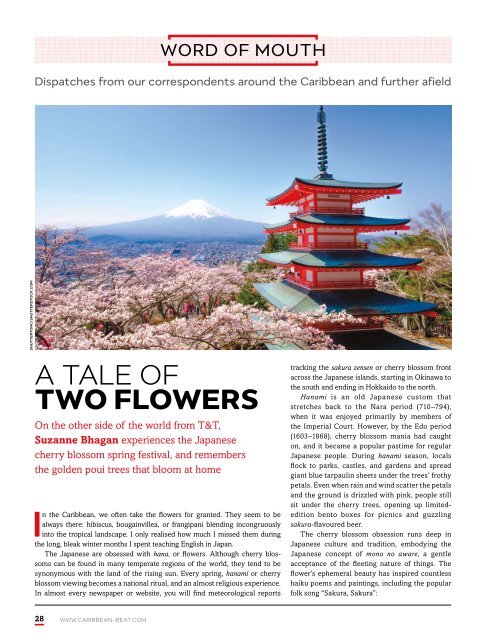Caribbean Beat — May/June 2018 (#151)
A calendar of events; music, film, and book reviews; travel features; people profiles, and much more.
A calendar of events; music, film, and book reviews; travel features; people profiles, and much more.
You also want an ePaper? Increase the reach of your titles
YUMPU automatically turns print PDFs into web optimized ePapers that Google loves.
WORD OF MOUTH<br />
Dispatches from our correspondents around the <strong>Caribbean</strong> and further afield<br />
Shuttertong/shutterstock.com<br />
A tale of<br />
two flowers<br />
On the other side of the world from T&T,<br />
Suzanne Bhagan experiences the Japanese<br />
cherry blossom spring festival, and remembers<br />
the golden poui trees that bloom at home<br />
In the <strong>Caribbean</strong>, we often take the flowers for granted. They seem to be<br />
always there: hibiscus, bougainvillea, or frangipani blending incongruously<br />
into the tropical landscape. I only realised how much I missed them during<br />
the long, bleak winter months I spent teaching English in Japan.<br />
The Japanese are obsessed with hana, or flowers. Although cherry blossoms<br />
can be found in many temperate regions of the world, they tend to be<br />
synonymous with the land of the rising sun. Every spring, hanami or cherry<br />
blossom viewing becomes a national ritual, and an almost religious experience.<br />
In almost every newspaper or website, you will find meteorological reports<br />
tracking the sakura zensen or cherry blossom front<br />
across the Japanese islands, starting in Okinawa to<br />
the south and ending in Hokkaido to the north.<br />
Hanami is an old Japanese custom that<br />
stretches back to the Nara period (710–794),<br />
when it was enjoyed primarily by members of<br />
the Imperial Court. However, by the Edo period<br />
(1603–1868), cherry blossom mania had caught<br />
on, and it became a popular pastime for regular<br />
Japanese people. During hanami season, locals<br />
flock to parks, castles, and gardens and spread<br />
giant blue tarpaulin sheets under the trees’ frothy<br />
petals. Even when rain and wind scatter the petals<br />
and the ground is drizzled with pink, people still<br />
sit under the cherry trees, opening up limitededition<br />
bento boxes for picnics and guzzling<br />
sakura-flavoured beer.<br />
The cherry blossom obsession runs deep in<br />
Japanese culture and tradition, embodying the<br />
Japanese concept of mono no aware, a gentle<br />
acceptance of the fleeting nature of things. The<br />
flower’s ephemeral beauty has inspired countless<br />
haiku poems and paintings, including the popular<br />
folk song “Sakura, Sakura”:<br />
28 WWW.CARIBBEAN-BEAT.COM


















